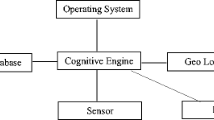Abstract
The work behind research is energy and time efficient spectrum occupancy analysis for the deployment of cognitive radio (CR) in India. The measurement campaign is initial step, which provides data for analysis. The campaigns conducted worldwide lead to a complex measurement set up. So, first aim was to provide solution for simple and compact measurement set up. A new wideband circularly polarized microstrip antenna is proposed instead of existing commercially available antennas; which show better spectrum sensing ability. The conventional spectrum occupancy analysis consumes more sensing time as well as network resources because it senses whole spectrum every time. This problem can be overcome by adopting predictive method to predict the behavior of spectrum. A new hybrid neural network (HNN) model is proposed as a predictor for spectrum behavior sensing through which the status of different channels can be predicted by proper learning. The required database for training and validation of HNN predictor was collected from the measurement campaign conducted first time for seven days at Solapur city, India. The HNN model performance was examined for popular bands, and different days (weekdays and weekend) using root mean square error (RMSE) performance metric. The result shows, it has greater ability as spectrum behavior sensing predictor, and would be better choice for energy as well as time efficient spectrum occupancy analysis for cognitive radio application.













Similar content being viewed by others
References
Sanders, F. H. (2006). Broadband spectrum surveys in Denver, CO, San Diego, CA, and Los Angeles, CA: Methodology, analysis, and comparative results. In Proceedings of IEEE Symposium on Electromagnetic Compatibility, Devner, USA, (pp. 988–993).
Mehdawi, M., Riley, N., Paulson, K., Fanan, A., & Ammar, M. (2013). Spectrum occupancy survey in Hull-UK for cognitive radio application: Measurement and analysis. Journal of Scientific and Technology Research, 2(1), 231–236.
Paulson, E., Adedgi, K., Popoola, J., Din, J., & Kamailah, S. (2017). Spectrum occupancy measurement: A case study for cognitive radio network in Lagos, Nigeria. Journal of Engineering and Applied Sciences, 12(4), 394–399.
Mehdawi, M., Riley, N., Paulson, K., Fanan, A., & Ammar, M. (2015). Spectrum occupancy measurements and lessons learned in the context of cognitive radio. In Proceedings 23rd Telecommunication Forum Telfor (TELFOR), Serbia, (pp. 196–199).
Barnes, S., Jansen, P., & Maharaj, B. (2013). Spectrum occupancy investigation: Measurements in South Africa. Elsevier Journal of Measurement, 46(9), 3098–3112.
Patil, K., Skouby, K., Chandra, A., & Prasad, R. (2011). Spectrum occupancy statistics in the context of cognitive radio. In Proceedings of 14th International Symposium on Wireless Personal Multimedia Communications (WPMC’11), Brest, France.
Ullah, U., & Koziel, S. (2019). A geometrically simple compact wideband circularly polarized antenna. IEEE Antennas and Wireless Propagation Letters, 18(6), 1179–1183.
Pan, Y., Yang, W., Zheng, S., & Hu, P. (2018). Design of wideband circularly polarized antenna using coupled rotated vertical metal plates. IEEE Transactions on Antenna and Propagation, 66(1), 42–49.
Bkassiny, M., Li, Y., & Jayweera, S. (2012). A survey on machine learning techniques in cognitive radios. IEEE Communication Surveys and Tutorials, 15(3), 1136–1159.
Abbas, N., Naseer, Y., & Ahmad, K. (2015). Recent advances on artificial intelligence and learning techniques in cognitive radio N/W. Wireless Communication and Networking, 15(20), 2–20.
Zhang, S., Hu, J., Bao, Z., Wu, J. (2015). Prediction of spectrum based on improved RBF neural network in cognitive radio. In Proceedings of the IEEE international conference on Wireless Information Network and Systems. Reykjavik, Iceland
Winston, O., Thomas, A., & Okellodongo, W. (2013). Comparing performance of MLP and RBF neural network for TV idle channel prediction. In Proceedings of the IEEE international conference on Information, Computing and Telecommunications, Lusaka, Zambia.
Moradazadeh, A., & Khaffafi, K. (2017). Comparison and evaluation of the performance of various types of neural networks for planning issues related to optimal management of charging and discharging electric cars in intelligent power grids. Emerging Science Journal, 1(4), 201–207.
Khademikia, S., Haghizadeh, A., Godini, H., & Khoramabadi, G. (2016). Artificial neural network-cuckoo optimization algorithm (ANN-COA) for Optimal control of Khorramabad wastewater treatment plant, Iran. Civil Engineering Journal, 2(11), 555–567.
Kashani, M., & Gheys, R. (2018). Comparison of three intelligent techniques for runoff simulation. Civil Engineering Journal, 4(5), 1095–1103.
Astanesh, A., & Gheisari, S. (2018). Review and coparison of routing metrics in cognitive radio networks. Emerging Science Journal, 2(4), 190–201.
Saljoughi, A., Mehvarz, M., & Mirvaziri, H. (2017). Attacks and intrusion detection in cloud computing using neural networks and practical swarm optimization algorithms. Emerging Science Journal, 1(4), 179–191.
Natonal Frequency Allocation Plan. 2018. Government of India. Department of Telecommunications. www.wpc.dot.gov.in.
Author information
Authors and Affiliations
Corresponding author
Additional information
Publisher's Note
Springer Nature remains neutral with regard to jurisdictional claims in published maps and institutional affiliations.
Rights and permissions
About this article
Cite this article
Shirgan, S.S., Bombale, U.L. Hybrid Neural Network Based Wideband Spectrum Behavior Sensing Predictor for Cognitive Radio Application. Sens Imaging 21, 27 (2020). https://doi.org/10.1007/s11220-020-00293-4
Received:
Revised:
Published:
DOI: https://doi.org/10.1007/s11220-020-00293-4




